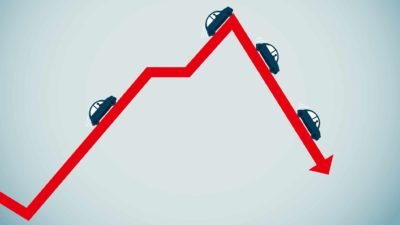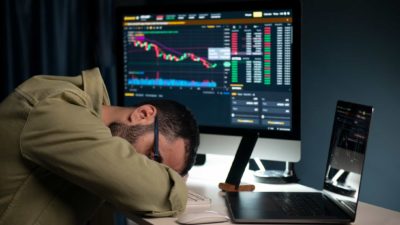This article was originally published on Fool.com. All figures quoted in US dollars unless otherwise stated.
For more than two years, the stock market has been virtually unstoppable. Last year, the iconic Dow Jones Industrial Average (DJX: .DJI), broad-based S&P 500 (SP: .INX), and innovation-inspired Nasdaq Composite (NASDAQ: .IXIC) galloped higher by 13%, 23%, and 29%, respectively, with all three indexes notching multiple record-closing highs.
Investors haven't needed to dig too deeply to locate the catalysts fueling this extended rally in equities. In no particular order, the powder keg of the current bull market includes:
- The rise of artificial intelligence (AI).
- Better-than-expected corporate earnings.
- A pullback in the prevailing rate of inflation from a four-decade high.
- A resilient U.S. economy.
- The return of Donald Trump to the White House.
- Investor euphoria surrounding stock splits.
While nothing has slowed this bull market rally, history has often shown that when things seem too good to be true, they usually are.
The stock market has reached this point on three occasions since January 1871
At any given time, there is bound to be a data point, metric, or forecasting tool that spells potential trouble for the U.S. economy and/or Wall Street. Some of the more recent examples include the first notable year-over-year decline in U.S. M2 money supply since the Great Depression, as well as the longest yield-curve inversion on record.
But among the "what if"s for the stock market, none screams louder than a valuation tool that's making history for only the third time in 154 years.
As the old idiom states, "value is in the eye of the beholder." Value is a relatively subjective term, and what one investor considers to be pricey might be viewed as a bargain by another.
The traditional valuation tool on Wall Street is the price-to-earnings (P/E) ratio, which divides a company's share price into its trailing-12-month earnings. While the P/E ratio is a quick value-comparison tool for mature businesses, it doesn't work particularly well with growth stocks and can get easily skewed during turbulent events, such as the COVID-19 pandemic.
A considerably more comprehensive valuation tool that allows for apples-to-apples comparisons is the S&P 500's Shiller P/E Ratio, which is also referred to as the cyclically adjusted P/E Ratio, or CAPE Ratio. The Shiller P/E is based on average inflation-adjusted earnings from the previous 10 years, which means that shock events won't be able to skew its readings.

S&P 500 Shiller CAPE Ratio data by YCharts.
When the closing bell rang on February 5, the S&P 500's Shiller P/E crossed the finish line with a reading of 38.23. For context, the average reading for the Shiller P/E when back-tested to January 1871 is just 17.2.
What's even more noteworthy is just how rare the magnitude of this deviation is above the historic average. Spanning 154 years, this marks only the third time during a continuous bull market that the S&P 500's Shiller P/E has reached a reading of at least 38.
The other two incidences include an all-time high in December 1999 of 44.19 and first week of January 2022 peak of just over 40. The former occurred just prior to the bursting of the dot-com bubble, which saw the S&P 500 and Nasdaq Composite respectively lose 49% and 78% of their value on a peak-to-trough basis. Meanwhile, the latter gave way to a bear market for the Dow Jones, S&P 500, and Nasdaq Composite between January 2022 and October 2022.
Widening the lens a bit further finds only six instances, including the present, where the Shiller P/E Ratio has surpassed 30 during a bull market in 154 years. All five previous occurrences were followed by declines ranging from 20% to 89% in at least one of the three major stock indexes.
Admittedly, the Shiller P/E isn't a timing tool and provides no clues as to when equities hit a temporary top. But when back-tested 154 years, it does have a flawless track record of foreshadowing eventual (and significant) downside in the stock market.
Time in the market trumps timing the market
While history rhyming and sending the stock market notably lower may not be what investors want to hear, there's a critical difference when it comes to trying to time short-term market moves and putting your money to work over long periods on Wall Street.
The blunt truth is that no matter how much we wish against stock market corrections, bear markets, crashes, and economic downturns, they're a normal and inevitable part of the respective investing and economic cycle. But what's vital to recognise is that cycles for the U.S. economy and stock market aren't mirror images of each other.
For example, the U.S. economy has worked its way through 12 recessions since World War II came to a close in September 1945. Spanning nearly eight decades, nine out of 12 recessions were resolved in less than a year. According to a report from the Congressional Research Service (CRS), the average recession from 1945 through 2009 endured just 11 months.
On the other hand, CRS notes the typical economic expansion stuck around for 58 months between 1945 and 2009, or nearly five years. Prior to the COVID-19 recession taking shape, the U.S. economy was enjoying an expansion that was over 10 years old. In other words, even though economic downturns are inevitable, they're historically short-lived.
This same cyclical nonlinearity can be seen on Wall Street.
The data set above was posted in June 2023 by the researchers at Bespoke Investment Group shortly after the benchmark S&P 500 was confirmed to be in a new bull market. It examines the length of every bull and bear market for this widely followed index dating back to the start of the Great Depression in September 1929.
In the 94-year period examined, the average S&P 500 bear market took 286 calendar days to complete, or about 9.5 months. What's more, the lengthiest bear market on record endured for 630 calendar days in the mid-1970s.
On the other hand, Bespoke's data set found the average of 27 S&P 500 bull markets lasted 1,011 calendar days, or roughly 3.5 times longer than the typical bear market. Further, if you include the current bull market rally (extrapolated to present day), over half — 14 out of 27 — of all bull markets have stuck around longer than the lengthiest bear market.
Short-term moves lower on Wall Street are virtually impossible to forecast. But history has conclusively shown that time in the market is far more valuable than trying to time the market.
This article was originally published on Fool.com. All figures quoted in US dollars unless otherwise stated.









